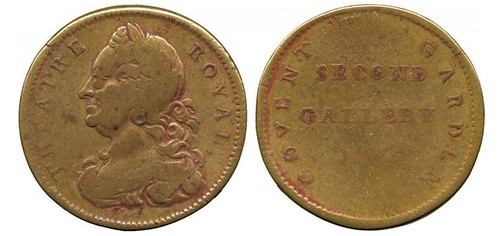
PREV ARTICLE
NEXT ARTICLE
FULL ISSUE
PREV FULL ISSUE
1755 DRURY LANE THEATRE ROYAL PASS
While browsing on Baldwin's site this week I came across this worn theatre pass token.
I worked in Central London for a time in 2007 and often visited Covent Garden.
-Editor

Great Britain, London, Covent Garden, Drury Lane, George II, Brass Ticket or Pass for the Theatre Royal, dated 1755, by J Kirk, obverse: bust of King George II to left, THEATRE ROYAL around, beaded border around all, reverse: SECOND GALLERY in two lines, date below, COVENT GARDEN around, edge plain, 30mm. The first theatre on the location was destroyed by fire in 1672. Thomas Killigrew built a larger theatre in the same spot, designed by Sir Christopher Wren which opened in 1674. This building lasted nearly 120 years, under leadership including Colley Cibber, David Garrick and Richard Brinsley Sheridan. The great Ulster Shakespearian actor Charles Macklin performed in this building. In 1791 the building was demolished to make way for a larger theatre which opened in 1794 (Davis & Walters 12/112). Well used, fine and very rare. To read the complete article, see: Drury Lane, Theatre Royal Pass 1755, rare (www.baldwin.co.uk/tokens/drury-lane-theatre-royal-pass-1755-rare.html?usrc=1)
This token reminded me of some numismatic items I saw in an exhibit in the Samuel Johnson house museum in London in 2007. Below is an excerpt from my London Diary of August 12, 2007. Numismatic items related to the theatre could make an interesting collection. Do any of our readers study these? Has a good article or monograph been written?
-Editor
In the attic room through 18 September is "Behind the Scenes", an exhibit on Georgian Theatres 1737-1784. In one case was a Shakespearian Jubilee Medallion, a silver medal struck in 1769 to "commemorate the Jubilee organized by David Garrick in Stratford- Upon-Avon to celebrate the bicentenary of Shakespeare's birth. The medal was displayed with its original hanger, ribbon and box. In another case was a group of 1778 Haymarket entry tokens. These were used as admission tickets to the Haymarket Theatre. The four apparently polished tokens were encased in Lucite. Their inscriptions included the words "Box", "Pit", "First Gall'y" and "Second Gall'y". The exhibit text explained that Boxes were for people "of quality". The Pit was for "ladies, gentleman and intellectuals." The First Gallery was for "tradesmen and their wives" and the Second Gallery was for "the mob." Finally, a third case contained another unusual numismatic item: "John Philip Kemble's 'George'", a crude-looking medal of "silver or nickel alloy c1781-1817." The text explained that "A George Medal was "... traditionally worn onstage by actors in the role of Richard III; it depicts George slaying the dragon'.
To read the earlier E-Sylum article, see:
WAYNE'S LONDON DIARY 11 AUGUST, 2007: SAMUEL JOHNSON'S HOUSE, ST. PAUL'S
(www.coinbooks.org/esylum_v10n32a18.html)
The Numismatic Bibliomania Society is a non-profit organization promoting numismatic literature. See our web site at coinbooks.org. To submit items for publication in The E-Sylum, write to the Editor at this address: whomren@gmail.com To subscribe go to: https://my.binhost.com/lists/listinfo/esylum All Rights Reserved. NBS Home Page Contact the NBS webmaster 
|